Caryn’s Thoughts
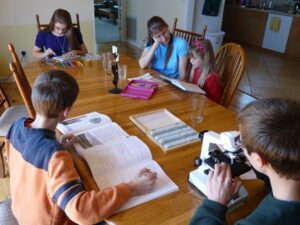
 As we come to a close in the year 2021, I think most of us would agree that this was one tough year, but then again, not as bad as 2020. So many things are in total disarray, and most people are unhappy with the direction our country is headed. Nevertheless, as Americans, we are ever hopeful for the future. It’s just in our nature. We are looking to the future of elections, times after Covid, and times when thing can get back to normal.
As we come to a close in the year 2021, I think most of us would agree that this was one tough year, but then again, not as bad as 2020. So many things are in total disarray, and most people are unhappy with the direction our country is headed. Nevertheless, as Americans, we are ever hopeful for the future. It’s just in our nature. We are looking to the future of elections, times after Covid, and times when thing can get back to normal.
While this has been a tough year, it has also been a year of fire. I suppose that could sound odd, but everyone has had to make their own decisions about things like school, health, jobs, and church. Some of these decisions were very difficult, and it felt like being thrown into the fire. Many have found themselves in trouble with everyone from family to Facebook. Posts have been deleted and friends have chosen to unfriend us…and yet, we stand. We must stand…or we will never be able to stand again. If we fail to use te freedoms and rights that belong to us, they might just be taken away from us. There just comes a time when you must choose to fight for what you believe in. And then there were the forest fires, the December tornadoes, the earthquakes in odd places, and the volcanoes…including a brand new one in Iceland. Things are getting pretty wild around here.
This has been a hard year. We have lost loved ones and friends, and yet we have learned to stand strong. We have comforted those who have lost loved ones. Helped those in quarantine. We have delivered groceries, meds, and meals. In essence, we have become good neighbors in the face of all the riots and hate. We have proven that we, as Americans will continue to be America-Strong. Yes, I think we are all ready to say goodbye 
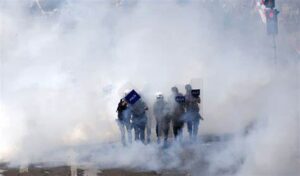 to 2021, and very ready to bring in 2022. I suppose that is because no matter how bad this year has been, we know that much has changed in a good way. Many things have been exposed and will continue to be exposed. What has been hidden is coming to light and will continue to do so. I really expect the year 2022 to be an amazing year, full of promise, and I am looking forward to what is to come. Tonight, I encourage you to stay hopeful and prepare for great days ahead.
to 2021, and very ready to bring in 2022. I suppose that is because no matter how bad this year has been, we know that much has changed in a good way. Many things have been exposed and will continue to be exposed. What has been hidden is coming to light and will continue to do so. I really expect the year 2022 to be an amazing year, full of promise, and I am looking forward to what is to come. Tonight, I encourage you to stay hopeful and prepare for great days ahead.
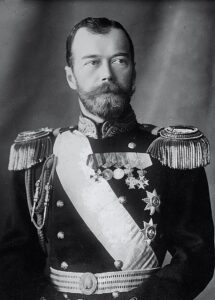 Czar Nicholas II and Czarina Alexandra were not always considered popular, in fact you could say that the tumultuous reign of Nicholas II, who was the last czar of Russia, was tarnished by his ineptitude in both foreign and domestic affairs that helped to bring about the Russian Revolution. Nevertheless, he was a part of the Romanov Dynasty, which had ruled Russia for three centuries.
Czar Nicholas II and Czarina Alexandra were not always considered popular, in fact you could say that the tumultuous reign of Nicholas II, who was the last czar of Russia, was tarnished by his ineptitude in both foreign and domestic affairs that helped to bring about the Russian Revolution. Nevertheless, he was a part of the Romanov Dynasty, which had ruled Russia for three centuries.
I think that his young son, Alexi’s health issues played a rather large part in what many would consider his failure to lead, but things were looking up for the family when a young Siberian-born muzhik, or peasant, who underwent a religious conversion as a teenager and proclaimed himself a healer with the ability to predict the future, won the favor of Czar Nicholas II and Czarina Alexandra. Grigory Efimovich Rasputin was able, through his ability, to stop the bleeding of their hemophiliac son, Alexei, in 1908.
Many people, from that time forward, began to criticize Rasputin for his lechery and drunkenness, if these things are true. The left-wing Bolsheviks were deeply unhappy with the government and began spreading calls for a military uprising. The Bolsheviks were a revolutionary party, dedicated to Karl Marx’s ideas, and they wanted a coup d’etat, which is a sudden, violent, and unlawful seizure of power from a government. That said, the last thing they needed was a “miracle-working holy man” advising the Czar. Rasputin exerted a powerful influence on the ruling family of Russia, infuriating nobles, church orthodoxy, and peasants alike. He particularly influenced the czarina and was rumored to be her lover.
Rasputin had to go, so sometime over the course of the night and the early morning of December 29-30, 1916, Grigory Efimovich Rasputin was murdered by Russian nobles eager to end his influence over the royal family. 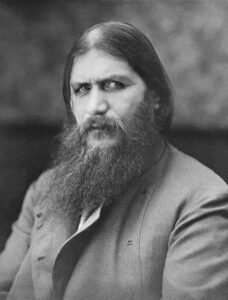 Still, that wasn’t all, and the rest of it should have scared them…to death. A group of nobles, led by Prince Felix Youssupov, the husband of the czar’s niece, and Grand Duke Dmitri Pavlovich, Nicholas’s first cousin, lured Rasputin to Youssupov Palace on the night of December 29, 1916. First, Rasputin’s would-be killers first gave the monk food and wine laced with cyanide…which miraculously had no effect on him. When he failed to react to the poison, they shot him at close range, leaving him for dead. Once again, they failed to kill him. Rasputin revived a short time later and attempted to escape from the palace grounds. They caught up with him and shot him again, and then beat him viciously. Finally, because Rasputin was still alive, they bound him and tossed him into a freezing river. His body was discovered several days later and the two main conspirators, Youssupov and Pavlovich were exiled. It was the beginning of the end. The Bolshevik Revolution of 1917 put an end to the imperial regime. Nicholas and Alexandra were murdered, and the long, dark reign of the Romanovs was over.
Still, that wasn’t all, and the rest of it should have scared them…to death. A group of nobles, led by Prince Felix Youssupov, the husband of the czar’s niece, and Grand Duke Dmitri Pavlovich, Nicholas’s first cousin, lured Rasputin to Youssupov Palace on the night of December 29, 1916. First, Rasputin’s would-be killers first gave the monk food and wine laced with cyanide…which miraculously had no effect on him. When he failed to react to the poison, they shot him at close range, leaving him for dead. Once again, they failed to kill him. Rasputin revived a short time later and attempted to escape from the palace grounds. They caught up with him and shot him again, and then beat him viciously. Finally, because Rasputin was still alive, they bound him and tossed him into a freezing river. His body was discovered several days later and the two main conspirators, Youssupov and Pavlovich were exiled. It was the beginning of the end. The Bolshevik Revolution of 1917 put an end to the imperial regime. Nicholas and Alexandra were murdered, and the long, dark reign of the Romanovs was over.
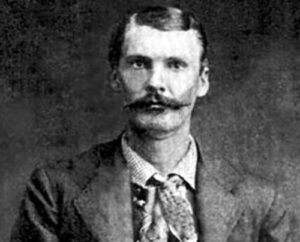 Most gunfighters in the Old West, either used their own names, or came up with a tough sounding gunfighter name, but somehow, John Calhoun Pinckney Higgins ended up with the rather feminine sounding name of “Pink.” Of course, it came from his second middle name, and may have even started as a childhood nickname. Nevertheless, John Calhoun Pinckney Higgins went by the gunfighter’s name of “Pink.”
Most gunfighters in the Old West, either used their own names, or came up with a tough sounding gunfighter name, but somehow, John Calhoun Pinckney Higgins ended up with the rather feminine sounding name of “Pink.” Of course, it came from his second middle name, and may have even started as a childhood nickname. Nevertheless, John Calhoun Pinckney Higgins went by the gunfighter’s name of “Pink.”
Higgins was a Texas gunfighter who was involved in the Horrell-Higgins Feud. The Horrell and Higgins families were friends and neighbors until the 1870s. The ranchers had settled in Lampasas County before the Civil War era. The five Horrell brothers…Mart, Tom, Merritt, Ben, and Sam first got into trouble with the State Police in 1873, when Captain Thomas Williams and seven men went to Lampasas to put a stop to the general lawlessness that was prevalent there. Williams fought with the Horrell boys and their brother-in-law, Bill Bowen, in Jerry Scott’s saloon. Mart Horrell who was badly wounded, was confined in the Georgetown jail, but as soon as he was well enough his brothers helped him to break out.
The relationship between the Horrells and Higgins blew up when, at the same time, because Pink’s son-in-law 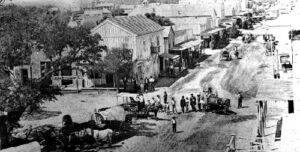 was also killed in the shootout. Soon, a vicious feud between the two families erupted, referred to as the Horrell-Higgins Feud. Over a several-year period, several shooting scrapes occurred, finally culminating in a shoot-out in the Lampasas town square on June 14, 1877, in which several men were killed. A few more skirmishes occurred before the feud was said and done.
was also killed in the shootout. Soon, a vicious feud between the two families erupted, referred to as the Horrell-Higgins Feud. Over a several-year period, several shooting scrapes occurred, finally culminating in a shoot-out in the Lampasas town square on June 14, 1877, in which several men were killed. A few more skirmishes occurred before the feud was said and done.
Around 1900, Higgins moved his ranch to the south of Spur, Texas. He continued his gunfighting ways and was said to have killed between 14-18 men during his lifetime. He died at his ranch of a heart attack on December 18, 1914.

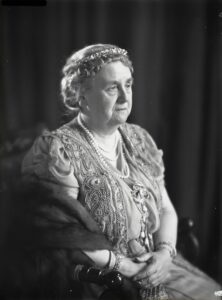 When a monarch becomes incapacitated or becomes monarch while under the age of 18, they can be placed under a regency, which became the normal procedure in 1937, with the passing of The Regency Acts. Prior to 1937, Regency Acts were passed only when necessary to deal with a specific situation. The Regency Act simply placed an adult, often a parent, or in the case of an incapacitated monarch, a spouse, in an advisory position over the monarch. The passing of The Recency Acts of 1937 made the procedure easier, because they realized that it could happen at any time.
When a monarch becomes incapacitated or becomes monarch while under the age of 18, they can be placed under a regency, which became the normal procedure in 1937, with the passing of The Regency Acts. Prior to 1937, Regency Acts were passed only when necessary to deal with a specific situation. The Regency Act simply placed an adult, often a parent, or in the case of an incapacitated monarch, a spouse, in an advisory position over the monarch. The passing of The Recency Acts of 1937 made the procedure easier, because they realized that it could happen at any time.
Wilhelmina Helena Pauline Maria, born August 31, 1880, was Queen of the Netherlands from 1890 until her abdication in 1948…reigning for nearly 58 years. Her reign was longer than any other Dutch monarch. The First and the Second World Wars, as well as the Dutch economic crisis of 1933, all took place during her reign. The really unusual thing about Queen Wilhelmina was that she became queen at the tender age of just 10 years old, under her mother, Emma of Waldeck and Pyrmont’s regency. Her father, King William III’s passing in 1890 brought about her ascension to the throne. Wilhelmina was their only child, and just a little girl, but that did not mean that she was incapable.
Following her ascension to the throne, Wilhelmina proved herself to be a great monarch. In a popular decision, she maintained Dutch neutrality during the First World War, while also solving many of her country’s industrial problems. Her successful business ventures made her the world’s first female billionaire in dollars. She also ensured that her family was one of seven European royal houses remaining in existence to this day. Of course, all that didn’t save her country from the German invasion of the Netherlands in 1940. At that time, Queen Wilhelmina was encouraged to flee to Britain, where she took charge of the Dutch government-in-exile. That did not mean that she was out of the spotlight and out of reach to her people. She frequently spoke to the nation over radio and came to be regarded as a symbol of the resistance. By 1948, she had already returned to the liberated Netherlands. She was the only survivor of the 16 monarchs who were sitting on their thrones at the time of her coronation.
By 1948, with her health declining, Wilhelmina abdicated the throne in favor of her daughter Juliana in  September of that year, and she retired to Het Loo Palace, where she died of cardiac arrest at the age of 82 on November 28, 1962. She was buried in the Dutch royal family crypt in the Nieuwe Kerk in Delft, on December 8, 1962. At her request and contrary to protocol, the funeral was completely in white to give expression to her belief that earthly death was the beginning of eternal life…something I really like. According to German Salic law, the House of Orange-Nassau-Dietz became extinct upon her death, but this rule is not recognized by royal Dutch succession laws. That law seems odd to me considering that her daughter, became queen after she abdicated.
September of that year, and she retired to Het Loo Palace, where she died of cardiac arrest at the age of 82 on November 28, 1962. She was buried in the Dutch royal family crypt in the Nieuwe Kerk in Delft, on December 8, 1962. At her request and contrary to protocol, the funeral was completely in white to give expression to her belief that earthly death was the beginning of eternal life…something I really like. According to German Salic law, the House of Orange-Nassau-Dietz became extinct upon her death, but this rule is not recognized by royal Dutch succession laws. That law seems odd to me considering that her daughter, became queen after she abdicated.
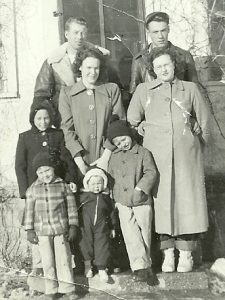
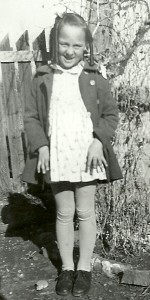 My husband, Bob Schulenberg’s aunt, Esther Hein and I have a birth story in common…well, a little bit. Hers is quite a bit more extreme than my own. We were both breech babies. A breech birth is really hard on both baby and mommy, and quite often these days, a breech birth would mean a Cesarian delivery. When I was born, they had to dislocate my hips to deliver me, but for Esther, it took 4 days for her delivery. That seems very dangerous to me, because it seems like the stress on mom and baby could be too much. I feel sorry for both moms, Esther’s mom, Vina Hein and my mom, Collene Spencer, because they had to do the work for the babies, Esther and me. I would have to say that they were supermoms, because they made it, and Esther and I got to be here because of them.
My husband, Bob Schulenberg’s aunt, Esther Hein and I have a birth story in common…well, a little bit. Hers is quite a bit more extreme than my own. We were both breech babies. A breech birth is really hard on both baby and mommy, and quite often these days, a breech birth would mean a Cesarian delivery. When I was born, they had to dislocate my hips to deliver me, but for Esther, it took 4 days for her delivery. That seems very dangerous to me, because it seems like the stress on mom and baby could be too much. I feel sorry for both moms, Esther’s mom, Vina Hein and my mom, Collene Spencer, because they had to do the work for the babies, Esther and me. I would have to say that they were supermoms, because they made it, and Esther and I got to be here because of them.
Esther is the oldest of Grandma Hein’s second family, my father-in-law, Walt Schulenberg and his sister, Marion Kanta being in her first family. She has two younger brothers, Eddie Hein and Butch Hein. Esther and Butch are the only ones left here on Earth. When my father-in-law married my mother-in-law, Joann (Knox) Schulenberg, they took Esther in during the winter months, because the Hein family lived outside of Forsyth, Montana on a ranch, and with the winters in Montana being what they often are, getting her to school wasn’t always easy, so living with her brother Walt and his wife Joann was the best solution. Those were special days for Esther, who became very close friends with Walt and Joann, as well 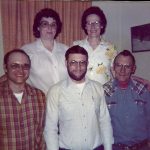
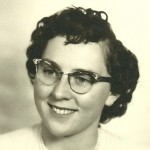 as little sister. Esther grew very close to her brother and sister-in-law. She also got close to their first child, Marlyce. Esther was only 10 years old, when Marlyce was born. That said, she had a number of years of school left, meaning that she might have been living with them for as much as 8 more years, during which time they would also have Debbie, and Bob. During her time there, while she might have been a trial at times, I’m quite sure she was also a big help to them as their family grew. I know they were always grateful for the help. Today is Aunt Esther’s birthday. Happy birthday Esther!! Have a great day!! We love you!!
as little sister. Esther grew very close to her brother and sister-in-law. She also got close to their first child, Marlyce. Esther was only 10 years old, when Marlyce was born. That said, she had a number of years of school left, meaning that she might have been living with them for as much as 8 more years, during which time they would also have Debbie, and Bob. During her time there, while she might have been a trial at times, I’m quite sure she was also a big help to them as their family grew. I know they were always grateful for the help. Today is Aunt Esther’s birthday. Happy birthday Esther!! Have a great day!! We love you!!
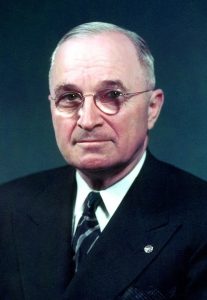 Some presidents are destined to greatness, and some are thrown into it. Some qualify in both categories. President Harry S Truman was born in Lamar, Missouri, on May 8, 1884. He was the oldest child of John Anderson Truman and Martha Ellen Young Truman. As is often tradition in families, he was named for his maternal uncle, Harrison “Harry” Young. His middle initial, “S” was to honor his grandfathers, Anderson Shipp Truman and Solomon Young. Truman’s brother, John Vivian, was born soon after he was, followed by sister Mary Jane.
Some presidents are destined to greatness, and some are thrown into it. Some qualify in both categories. President Harry S Truman was born in Lamar, Missouri, on May 8, 1884. He was the oldest child of John Anderson Truman and Martha Ellen Young Truman. As is often tradition in families, he was named for his maternal uncle, Harrison “Harry” Young. His middle initial, “S” was to honor his grandfathers, Anderson Shipp Truman and Solomon Young. Truman’s brother, John Vivian, was born soon after he was, followed by sister Mary Jane.
President Truman was the 33rd President of the United States, becoming president after the death of President Franklin D Roosevelt. He was a lifetime Democrat, although he might not recognize the party today, and as we have seen, there are good and bad politicians in both parties. Following the death of Roosevelt, who was rather anti-Israel, Truman implemented the Marshall Plan to rebuild the economy of Western Europe and established both the Truman Doctrine and NATO to contain the expansion of communism. He went on to propose numerous liberal domestic reforms, but few were enacted by the Conservative Coalition that dominated the Congress at 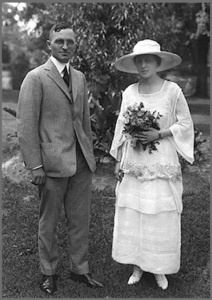 that time. While some of his policies, were not good for America or the world, he was known for his support of Israel. On May 14, 1948, Prime Minister David Ben-Gurion read the proclamation of nationhood. Striking the speaker’s table for emphasis, he announced, “The name of our state shall be Israel.” It was a noble effort, but the new state would need to be recognized to carry much weight.
that time. While some of his policies, were not good for America or the world, he was known for his support of Israel. On May 14, 1948, Prime Minister David Ben-Gurion read the proclamation of nationhood. Striking the speaker’s table for emphasis, he announced, “The name of our state shall be Israel.” It was a noble effort, but the new state would need to be recognized to carry much weight.
Shortly before making his speech, President Truman made some last-minute changes, which are still visible on the speech. The American statement recognized the new State of Israel. Israel’s American recognition came shortly after midnight in Palestine, just a few minutes after the new nation was proclaimed. There were a number of nations who did not want Israel to be a nation again, but President Truman took matters into his own hands, and it became a reality. For his help, President Truman was gifted a Torah from Dr Chaim Weizmann, who was the first president of the new state of Israel, during Weizmann’s visit to the White House on May 25th, 1948. I suppose some people might disagree, but for me, this was the crowning moment of Truman’s presidency.
After his wartime service, Truman returned to Independence, where he married Bess Wallace on June 28, 1919. 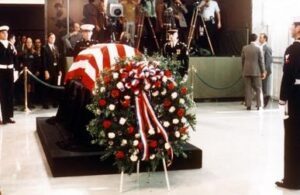 The couple had one child, Mary Margaret Truman. On December 5, 1972, Truman was admitted to Kansas City’s Research Hospital and Medical Center with pneumonia. He developed multiple organ failure, fell into a coma, and died at 7:50am on December 26, 1972, in Independence, Missouri at the age of 88. Bess Truman opted for a simple private service at the library rather than a state funeral in Washington. A week after the funeral, foreign dignitaries and Washington officials attended a memorial service at Washington National Cathedral. Bess died in 1982 and is buried next to Harry at the Harry S Truman Library and Museum in Independence, Missouri.
The couple had one child, Mary Margaret Truman. On December 5, 1972, Truman was admitted to Kansas City’s Research Hospital and Medical Center with pneumonia. He developed multiple organ failure, fell into a coma, and died at 7:50am on December 26, 1972, in Independence, Missouri at the age of 88. Bess Truman opted for a simple private service at the library rather than a state funeral in Washington. A week after the funeral, foreign dignitaries and Washington officials attended a memorial service at Washington National Cathedral. Bess died in 1982 and is buried next to Harry at the Harry S Truman Library and Museum in Independence, Missouri.

 Depending on who you talk to, you will hear a variety of thoughts on Christmas, from it being a pagan holiday to it being a Christian holiday, to Jesus being born in the spring…which is interesting to me, because my nephew, Barry Schulenberg celebrated his December 11th birthday on June 11 for a long time so that it wasn’t so close to Christmas…thereby spreading his gift receiving out over the year. Noe a bad idea. Really, my point is that the time of year really doesn’t matter. It is the fact that you are celebrating the birth of our Lord and Savior. I don’t think He cares, one way or the other, if we have the date wrong. Birthdays are often celebrated on a day other than the actual day…and Christmas has also been celebrated on a day other than the 25th of December, due to work schedules, illness, and distance.
Depending on who you talk to, you will hear a variety of thoughts on Christmas, from it being a pagan holiday to it being a Christian holiday, to Jesus being born in the spring…which is interesting to me, because my nephew, Barry Schulenberg celebrated his December 11th birthday on June 11 for a long time so that it wasn’t so close to Christmas…thereby spreading his gift receiving out over the year. Noe a bad idea. Really, my point is that the time of year really doesn’t matter. It is the fact that you are celebrating the birth of our Lord and Savior. I don’t think He cares, one way or the other, if we have the date wrong. Birthdays are often celebrated on a day other than the actual day…and Christmas has also been celebrated on a day other than the 25th of December, due to work schedules, illness, and distance.
The point is that Christmas…on whatever day it is celebrated…is the celebrate Jesus’ birth. Our Savior, the Son of God, the Word of the Trinity, took on flesh to become a human and gave up Heaven to come to Earth to die  for us, that we might live in Heaven with Him and that we can become the Righteousness of God, even here on Earth. That is the reason we celebrate Jesus, and the reason we always will. People can call Christmas whatever they want to, but those of us who serve the Lord will always know exactly why Christmas is important. They can never take that away from us.
for us, that we might live in Heaven with Him and that we can become the Righteousness of God, even here on Earth. That is the reason we celebrate Jesus, and the reason we always will. People can call Christmas whatever they want to, but those of us who serve the Lord will always know exactly why Christmas is important. They can never take that away from us.
Jesus was the greatest gift God ever gave to the world, and that is why we give gifts to this day It is to remember the greatest gift ever given, because of a love that is beyond anything we can possibly imagine. If you want to really understand the love of your Heavenly, remember how much your parents love you, and then multiply it by infinity. That is the love of God. The Bible says in John 3:16, “For God so loved the world, that He gave His only begotten Son, that whosoever believes in Him, should not perish, but have everlasting Life.” God is Love, and He gave His Son for us. Praise God, Happy birthday Jesus, and Merry Christmas to all of you.
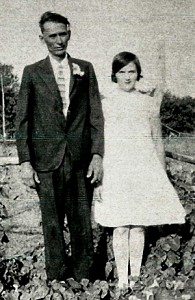
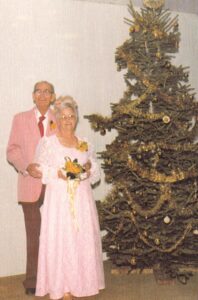 Years ago, especially in the old west and during the depression years, travel wasn’t so easy, even from just one town over or across town, so quite often, holidays were mixed with weddings, just because of the convenience of it, and so that family gatherings could serve two purposes. I’m not sure if that was the reason why my grandparents, George and Hattie Byer, chose Christmas Eve for their wedding day or not, but the fact that they did, made Christmas Eve just that much mor special for our family. It always seemed like that day had more sparkle and shine to me. I think it did to them too. Having the anniversary cake as part of the celebration…especially a celebration that more often included pie, was just extra.
Years ago, especially in the old west and during the depression years, travel wasn’t so easy, even from just one town over or across town, so quite often, holidays were mixed with weddings, just because of the convenience of it, and so that family gatherings could serve two purposes. I’m not sure if that was the reason why my grandparents, George and Hattie Byer, chose Christmas Eve for their wedding day or not, but the fact that they did, made Christmas Eve just that much mor special for our family. It always seemed like that day had more sparkle and shine to me. I think it did to them too. Having the anniversary cake as part of the celebration…especially a celebration that more often included pie, was just extra.
I think of them more this time of year, even though they have been in Heaven now for 41 and 33 years, respectively. They were the only grandparents I really knew, since my dad’s dad passed before I was born, and his mom just 6 months after I was born. So, Grandma and Grandpa Byer were my only grandparents, and when they left us, it was a very sad day. Of course, we know that they are in our future now, and we will see them again, but on this their joyous wedding anniversary, we miss them even more than we normally do.
Grandma and Grandpa always made a big deal about Christmas. Even when the family got to be too big to get together on Christmas Day, they started a tradition that continues to this day…the Byer Family Christmas Party. By doing the party, and renting a hall, we could all be together at the same time. There was no way for the family, as big as it had become, to get together on Christmas Day in Grandma and Grandpa’s house, or anyone’s house, for that matter. Their nine children have grown to a family of well over 400, and the Byer 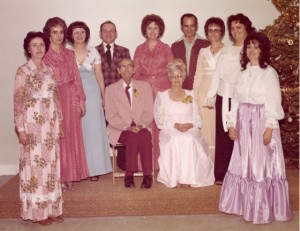
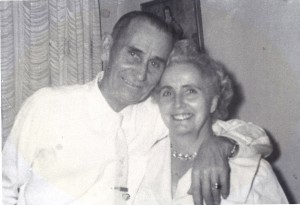 Family Christmas Party continues on, in their honor. Grandpa once said to Grandma, “Mommy, look what we started.” Yes, they certainly did start something that has grown into a something big and beautiful…an amazing family. Yes, I do think about them a little more this time of year and miss them even more. Merry Christmas in Heaven Grandma and Grandpa, and all the family who has gone to Heaven before us. We can’t wait until we are all together again.
Family Christmas Party continues on, in their honor. Grandpa once said to Grandma, “Mommy, look what we started.” Yes, they certainly did start something that has grown into a something big and beautiful…an amazing family. Yes, I do think about them a little more this time of year and miss them even more. Merry Christmas in Heaven Grandma and Grandpa, and all the family who has gone to Heaven before us. We can’t wait until we are all together again.
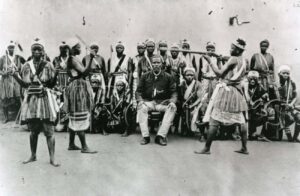 The Dahomey Amazons were given a number of different names, but the Mino, as they were called, were mostly an army recruited from among the king’s wives. They were a large group of 4,000 to 6,000 female warriors. Strangely, they made up about one third of the overall Dahomey military. King Houegbadja, who ruled from 1645 to 1685…the third King of Dahomey, is said to have originally started the group which would become the Amazons as a corps of elephant hunters called the gbeto. They were commonly known as Mino or “our mothers” and were the royal bodyguards of the kings of Dahomey, which is currently the Republic of Benin.
The Dahomey Amazons were given a number of different names, but the Mino, as they were called, were mostly an army recruited from among the king’s wives. They were a large group of 4,000 to 6,000 female warriors. Strangely, they made up about one third of the overall Dahomey military. King Houegbadja, who ruled from 1645 to 1685…the third King of Dahomey, is said to have originally started the group which would become the Amazons as a corps of elephant hunters called the gbeto. They were commonly known as Mino or “our mothers” and were the royal bodyguards of the kings of Dahomey, which is currently the Republic of Benin.
These women might have been the wives of the king, but that did not make  them wimps. Their training was intense and fierce. They learned survival skills and indifference to pain and death, storming acacia-thorn defenses in military exercises and executing prisoners. Discipline was emphasized. Once trained, the Mino were known to fight with incredible bravery and “audacity.” Due to the profits from the slave trade, they were also armed with Danish flintrocks and Winchester repeaters, which would come in handy when they took on the French army.
them wimps. Their training was intense and fierce. They learned survival skills and indifference to pain and death, storming acacia-thorn defenses in military exercises and executing prisoners. Discipline was emphasized. Once trained, the Mino were known to fight with incredible bravery and “audacity.” Due to the profits from the slave trade, they were also armed with Danish flintrocks and Winchester repeaters, which would come in handy when they took on the French army.
The kings recruited both men and women soldiers from foreign captives, though women soldiers were also recruited from free Dahomean women. Some of these “women” enrolled as young as 8 years old, if you can call an 8-year-old girl a woman. Some women in Fon society became soldiers voluntarily, while others were involuntarily enrolled, if their husbands or fathers complained to the king about their behavior. Imagine that…but then times were different. Apparently, membership among the Mino was supposed to teach them to use any aggressive character traits for the purpose of war. During their membership they were not allowed to have 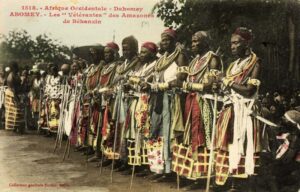 children or be part of married life, although many were legally married to the king. Serving in the Mino offered women the opportunity to “rise to positions of command and influence” in an environment structured for individual empowerment. The Mino were also wealthy and held high status. These women were true fighters and very determined. In a bold move, King Behanzin started a war with France in 1890. Despite being a formidable force, the French lost several major battles against the Mino early on. It just goes to show that women can be warriors too. These women were a long-standing force. The last known member of the Dahomey Amazons died in 1979.
children or be part of married life, although many were legally married to the king. Serving in the Mino offered women the opportunity to “rise to positions of command and influence” in an environment structured for individual empowerment. The Mino were also wealthy and held high status. These women were true fighters and very determined. In a bold move, King Behanzin started a war with France in 1890. Despite being a formidable force, the French lost several major battles against the Mino early on. It just goes to show that women can be warriors too. These women were a long-standing force. The last known member of the Dahomey Amazons died in 1979.
 As Christmas approaches, with all of its feasts, we start thinking of all the goodies we will make and eat. For many people, pie is a big part of holiday meals, not to mention other meals year-round. People just simply love pie. They would bake them to share or give as gifts, and especially to have with tea when guests came by, but the one thing I can’t imagine is any kind of worship involving pie. Nevertheless…
As Christmas approaches, with all of its feasts, we start thinking of all the goodies we will make and eat. For many people, pie is a big part of holiday meals, not to mention other meals year-round. People just simply love pie. They would bake them to share or give as gifts, and especially to have with tea when guests came by, but the one thing I can’t imagine is any kind of worship involving pie. Nevertheless…
In 1644, an English statesman named Oliver Cromwell, came up with the totally irrational idea that pie was a pagan form of pleasure, so he banned pie. The eating of pie, baking pies, even thinking about pie. Well, maybe not exactly, but for the next sixteen years, no one could eat pie. So, like the prohibition years that would come about in the future, the eating of pie went…underground.
I can’t imagine having to bake and eat a pie in secret. For one thing, you can smell a pie baking. The aroma fills the house, and in the 1600s, they didn’t have a conventional oven like we have today. Dutch ovens were the first ovens used for baking. The pot would be embedded in the hot coals and ashes, and then more coals would be placed on its flat lid. Really, any large iron pot could be used as a Dutch oven. Double boilers were also used at this time. This meant that the aroma of the pie filled the area even more, because of the open chimney or the open pit in the outdoors where the pie was baked. I’m not sure if a violation of this new prohibitive law was a fine, jail, or death, but it was certainly something that made people realize that they must really want to bake that pie, if they would take such a risk for the chance to bake one.
Finally, in 1660, the Restoration leaders lifted the ban on pie baking, and the people rejoiced. I don’t know if  they went as crazy about getting back to eating pie as they did the end of the Prohibition years, but I would imagine that there were a few gatherings to celebrate the new-found freedom. These days we can’t imagine such a silly idea concerning pie, but with every revelation, there must first have been a misconception. Oliver Cromwell somehow saw something in pie that made him believe the way he did, so seriously that he would make a law. Perhaps, it was his own addiction to pie that made him think it must be bad…not that I know that he was addicted to pie, but people have given up food and drink items for that reason for centuries. In fact, people have had confused ideas when it comes to religion for centuries.
they went as crazy about getting back to eating pie as they did the end of the Prohibition years, but I would imagine that there were a few gatherings to celebrate the new-found freedom. These days we can’t imagine such a silly idea concerning pie, but with every revelation, there must first have been a misconception. Oliver Cromwell somehow saw something in pie that made him believe the way he did, so seriously that he would make a law. Perhaps, it was his own addiction to pie that made him think it must be bad…not that I know that he was addicted to pie, but people have given up food and drink items for that reason for centuries. In fact, people have had confused ideas when it comes to religion for centuries.

